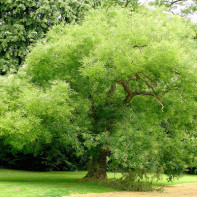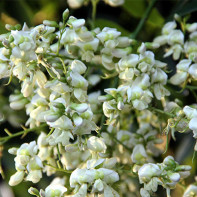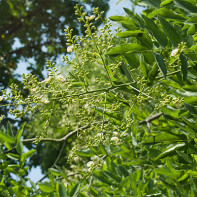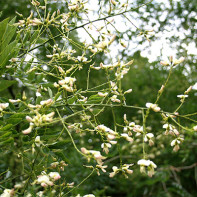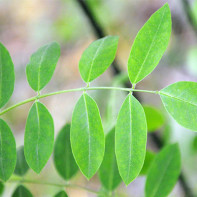Japanese Sophora: medicinal properties and contraindications
Such a tree as Japanese Sophora has gained great popularity in medicine. The healing properties of this tree have not yet been fully studied, but it is still considered a treasure trove of useful substances. Preparations from Japanese acacia are indicated for the treatment of various kinds of diseases of the cardiovascular, respiratory, genitourinary and digestive systems.
- Chemical composition
- How it looks and where it grows
- Collection and storage
- Therapeutic properties of Sophora japonica
- Japanese Sophora in traditional medicine
- Kinds of medicinal compositions
- Infusion
- Tincture
- Decoction
- Tea
- Salve
- Oil
- Drugs with Japanese Sophora
- Cosmetic applications
- What is the usefulness of Japanese Sophora honey
- Is it possible to eat the fruits of Sophora japonica
- Contraindications to use
Chemical Composition
Sophora has a unique chemical composition that could be the envy of any other medicinal plant. Among the useful components include alkaloids, which can relieve pain, eliminate inflammation, have sedative and hypnotic effect.
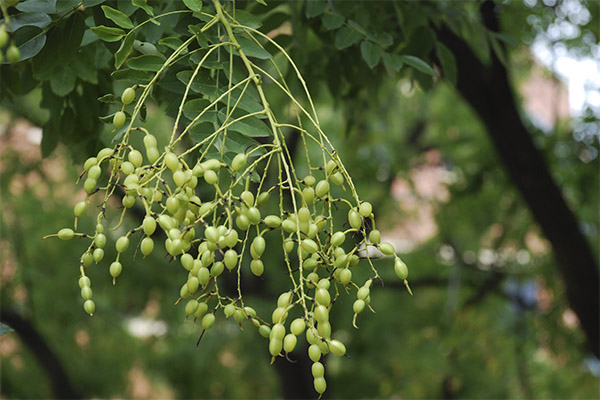
In addition, flavonoids are found in this plant. Rutin, or otherwise known as vitamin P, is characterized by its rejuvenating and regenerating properties, stabilizes metabolic processes in the body, gives strength to blood vessels. Quercetin helps to reduce blood pressure. Both of these components have a sedative and analgesic effect.
Ascorbic acid found in Sophora provides increased blood clotting, increases the body's defenses, and strengthens capillary walls. Glycosides in the product provide normal activity of the cardiovascular system.
Sophora japonica is full of organic acids that act as antispasmodic, anti-inflammatory, regenerating, antibacterial agents. Mineral range of culture is represented by Ca, Fe, K, I, Mg, Zn.
Due to the presence of fatty oils, linoleic acid, the culture is widely used in cosmetology.
How it looks and where it grows
Sophora is a member of the legume family. In appearance, it resembles an acacia, because it has a large, branchy crown.
Its other name is the weeping tree. The plant is considered a symbol of Beijing. Chinese healers assure that it is a tree of longevity with strong health, apply for therapeutic purposes practically all parts of the culture. For example, healing compositions in the form of decoctions, infusions and other medicinal forms are made from bark, inflorescences, fruits and even the root. In addition, the Japanese acacia is grown as an ornamental. It prefers an arid climate, is able to grow in shady areas, but strong winds and temperature values below zero can kill it. It grows in meadows, along ponds and on hills.
Sophora can grow to a height of 25 m. The bark of the tree is characterized by its gray coloring, covered with cracks. Leaves have an oblong shape, before the onset of winter they usually fall off. There are no thorns on the branches. The first flowers develop usually in the 30th year of the plant's existence. At the same time it blooms once in two years. Flowers are white with a yellowish tint, fragrant and resemble panicles.
The fruits of this representative of the flora are cylindrical unopened beans, 7-8 cm in length. Unripe specimens are characterized by a dark green color; as they ripen, they turn brown or black. This usually occurs in mid-autumn, and they stay that way on the tree until spring.
The crop prefers soil with more clay and less sand and lives along ponds and on stony areas. It grows in Japan, Mongolia, and Vietnam. Cultivated today in regions of the Russian Federation as well, in Krasnodar Territory, Altai and the Caucasus.
Gathering and storage
Pick on a sunny day. A large concentration of useful elements is concentrated in the unopened buds and unripe beans.
Inflorescences should be harvested at the start of summer. They should be cut with a secateurs, separating them from each other. The collected raw material should sit in a shady place for a couple of hours. After that, it should be moved to a shady and dry room that is well ventilated. It is necessary to stir the collected material periodically and make sure that it is not exposed to moisture or direct sunlight. If you use a drying machine for this purpose, the temperature in such a device should be 40-45 degrees. Dried raw material has a faint odor.
Unripe pericarp of the tree is fleshy, the seeds of Japanese Sophora large. Gathering these parts of the culture should begin with the onset of September, before the first frosts, otherwise the fruits will not have any health benefits. Dry them in a ventilated and shaded place or in an oven at 30 degrees.
Ready herbal medicinal raw materials are stored in paper bags or glass jars. Healing properties of preparations are preserved for 12 months.
From the leaves can be prepared solutions for rinsing, from the seeds are produced essential oils designed to remove parasites from organs and systems.
Therapeutic properties of Japanese Sophora
Since ancient times, Japanese acacia has been presented as a product endowed with medicinal characteristics.
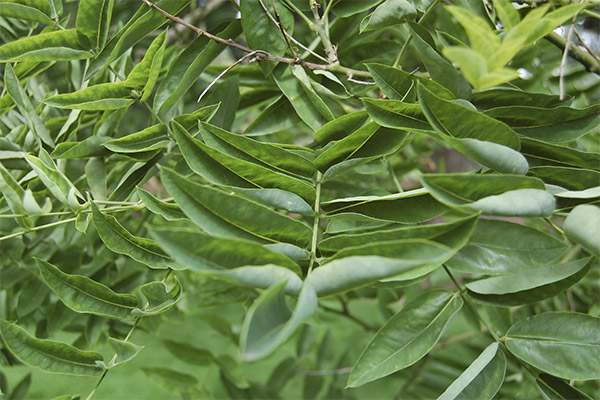
On the basis of this culture, many preparations are made in the pharmaceutical industry. In folk medicine, the same stifnolobium is widely used to obtain infusions and alcoholic compositions. Honey obtained from the inflorescences of Sophora protects a person from the occurrence of atherosclerosis, prevents the deposition of cholesterol formations, blood clots, helps to normalize blood pressure, purify the circulatory system.
In addition, the plant is able to have a regenerating effect, as it provides wound healing. The product increases immunity, prevents allergic reactions, that is, it clears the skin of rashes, reducing itching. Sophora also helps to thin the blood, increase the elasticity of blood vessels, and dissolve blood clots and cholesterol plaques.
With the help of this acacia plant you can cure barley, stimulate hair growth. The plant helps to liquefy and expel phlegm from the respiratory organs, it is characterized by antioxidant qualities. Sophora japonica is able to regulate processes in the urogenital system, reduce swelling. Moreover, it normalizes metabolic processes, reduces cholesterol and blood glucose. Thus, the raw material obtained from this culture can prevent the deterioration of vision, stroke and heart attack. In the presence of gangrene, the product will improve blood circulation in the extremities, curing hemorrhagic diathesis. Stifnolobium medicines are used for stomach ulcers, heart disease, varicose veins, hemorrhoids and even lupus.
In gynecology, the medicinal parts of the tree are valued for their anti-cancer, anti-inflammatory and antimicrobial qualities. Prescribed medicines based on this plant for various female pathologies. In addition, such medicines will help to stop bleeding, eliminate inflammation in the uterus and its appendages, cure infertility, restore the activity of the reproductive system. It is usually used internally, but is allowed and external consumption as douches. These herbal preparations are useful at menopause, as the herb is able to adjust the hormonal balance, as well as to get rid of unpleasant symptoms and flushes during menopause.
Nowadays, the anti-tumor properties of this representative of the flora are increasingly mentioned. Certain components of Sophora can stop the growth of cancer cells, prevent the aggravation of such formations and protect the body from the transition of the disease to more dangerous stages. Often this herb is prescribed in conjunction with other medicines. In severe conditions, the plant is able to eliminate swelling and relieve severe inflammation. In addition, the tree is a strong natural immunostimulant, which can support the protective functions of the body during the deterioration of health and rehabilitation of the patient.
As mentioned above, Sophora, or more precisely, its fruits are useful for diseases of the cardiovascular system. Vitamin P, which is a part of the plant raw material, acts as the main drug for ailments of this system. This substance is not synthesized by the body, so it must come from outside. Thus, Sophora provides for the cleansing of blood vessels from cholesterol, prevents the formation of blood clots. Useful plant at high blood pressure, angina. It helps to strengthen vascular walls, ensure normal blood flow, make capillaries more dense. It is used as a prophylactic against stroke, internal hemorrhages.
Japanese acacia is considered a natural antioxidant that can cleanse the liver and blood of toxic substances. It helps to eliminate intoxication.
Noted beneficial effects of the plant on the activity of the thyroid and pancreas, stabilizing the hormonal background. It is scientifically proved that the product is endowed with hypoglycemic properties. The drug is shown at different stages of diabetes, but only under the supervision of a specialist. During therapy, it is important to adhere to a diet. Usually included in the complex treatment.
The plant is useful for the organs of the digestive tract. Due to its anti-inflammatory quality, sophora provides healing of the mucous membranes. Most often, preparations of plant origin are used for peptic ulcer, as well as gastritis, which is accompanied by increased acidity levels. They are also indicated for pancreatitis, parasites in the liver, appetite disorders. Folk healers claim that in the presence of an epigastric ulcer, treatment with this herb can provoke severe pain. This indicates that the process of tissue renewal begins. But still, if any unwanted phenomena appear, it is necessary to inform the doctor.
The tincture, usually used internally, can be applied externally. This remedy is shown for gargling the throat, the mouth. It can be used to make compresses for rheumatism. In this case, such lotions will help to relieve swelling and reduce pain. Decoctions based on the herb are effective for psoriasis, dermatitis, pus formations, wounds caused by frostbite or burns.
Sophora japonica in folk medicine
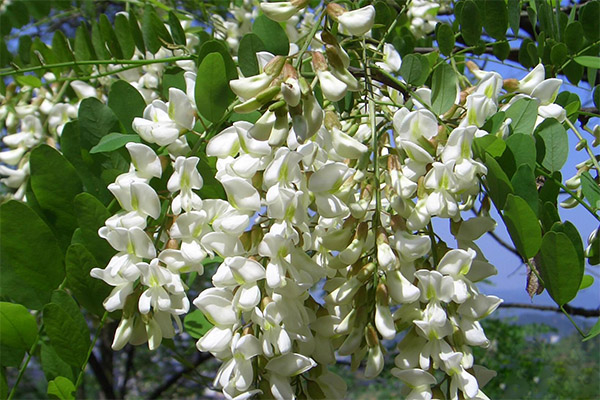
- If you mix 20 grams of dried flowers with a glass of boiling water and infuse for several hours, you get an effective potion used to strengthen the vascular walls and reduce internal bleeding. Before using the composition must be cooled and filtered. Take 1.5 tbsp. in 3 doses after a meal.
- In order to remove substances of organic origin from the walls of blood vessels, you need to prepare a solution. In this case, 50 g of fruits and flowers of "acacia" need to pour 0.5 liters of vodka, insist a month. The resulting tincture to drink 1 tsp. three times a day for 3 months. To make a water-based infusion, you need to mix 1 tbsp of Sophora and 250 ml of water and leave for 12 hours in a thermos.
- To prevent bleeding and the therapy of chronic ulcers, it is recommended to consume 1 tsp. of the remedy prepared from a mixture of fresh beans and alcohol 56%. Mix both components in equal proportions. The resulting mass insist 3 weeks. Take the ready remedy 3-4 times a day. In case of burns this solution can be applied externally in the form of a compress.
- Sophora is characterized by hypotensive properties. To cure hypertension, you need to prepare the following preparation: 20 g of inflorescences infused in 100 ml of alcohol with a concentration of 70%. Insistence to continue for 7 days. The finished product to drink 25 drops three times a day for 3 weeks in a row.
- For the treatment of gastritis and liver pathologies, a tincture is shown, for which 50 dried raw materials should be mixed with 100 ml of vodka. The medicine will be ready in 10 days.
- To protect the body from the deposition of salts, the remedy obtained by pouring 15 g of herbs with a glass of boiling water is considered effective. This mixture insist in a thermos for 10-12 hours. Filter the prepared solution and drink 2 tablespoons twice a day.
- To make a potion that strengthens the immune system, you need 20 grams of dried herbal raw materials, pour 500 ml of hot water and boil over low heat for about 5 minutes, then leave for half an hour and strain. A glass of broth prepared to divide into 3 portions and use before meals.
- The tincture, designed to tone the body, should be drunk three times a day before a meal, 1 tbsp.
- To prevent internal bleeding, you need to prepare a decoction of 1 tbsp of raw materials and 1 cup of boiling water. Insist the resulting mass for a couple of hours. After that, strain the liquid and take 1 tbsp. three times on an empty stomach.
- Japanese tree is used to remove cholesterol deposits from the blood vessels, as well as a beneficial effect in frequent headaches and constipation. To make a drug that will help to cope with such ailments, you need to grind 100 grams of beans, pour them 1 liter of apple cider vinegar and put in a dark room for a month, shaking the container with the preparation from time to time. Ready to dilute the preparation with water. So, 150 ml of water is enough to 1 tsp. Take 3 times a day for 3 weeks. Such a tincture is contraindicated in cases of high acidity of the stomach.
- Oil of Japanese acacia is able to heal wounds, sores and burns. To do this, it is sufficient to smear such oil on the affected areas. In addition, if you drop it into the nasal passages several times a day, you can get rid of rhinitis, inflammation of the nasopharynx. The runny nose will disappear on the third day, the wounds will heal within a few days. Rashes with psoriasis can also be cured with the help of this remedy. In this case, the therapeutic effect is achieved after a month and a half of regular use.
Types of medicinal compositions
Despite the fact that Sophora is a poisonous plant, in certain doses designated by the doctor, it has a therapeutic effect. Therefore, it is used for preventive and therapeutic purposes. Ways of using the plant are different, you can take the remedy internally or externally. The list of diseases that the Japanese Sophora can cure is quite large. There are several types of therapeutic compositions, which are most often practiced in medicine.
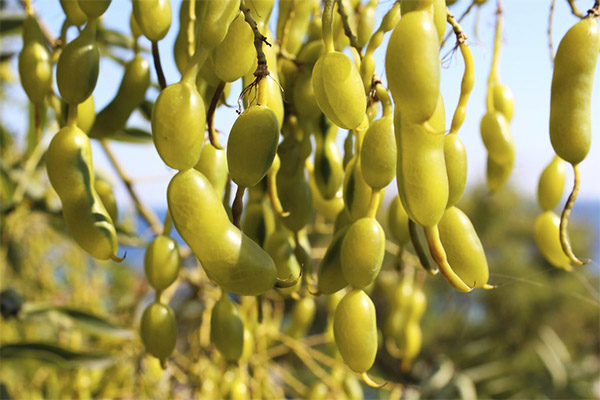
Infusion .
To obtain an infusion, you need to take 1 tbsp. of styphnolobium beans and pour 250 ml of steep boiling water. In this form, the mixture should stand in a thermos for about 5-6 hours. Before use, it is recommended to strain the composition. Take 1 tbsp. 3 times daily after a meal.
Tincture .
It is known that vitamin PP is more effectively dissolved in alcohol. Therefore, this dosage form has certain advantages. This type of medicinal composition is used for insomnia, neurasthenia, as well as during menopause. In addition, a preparation based on Japanese Sophora is able to cure bronchitis, tuberculosis, thrombophlebitis, stroke and varicose veins. Adenoma, prostatitis is also eliminated after the use of a useful tincture.
It is necessary to take 50 g of dry raw materials, grind it and pour it into a bowl, where to add 0.5 liters of vodka, insist 4 weeks in a dark place, and after the specified period, filter it. Ready to take the drug several times a day at 20 drops. The course of treatment should last for 30 days. After that, you should take a break of 10 days and repeat if necessary.
When treating with this remedy, driving is contraindicated, you should also limit physical and mental stress, which require special concentration.
Decoction
A solution of the roots of the tree is indicated for jaundice, tuberculosis. To prepare this composition, you need to mix 1 large spoon of roots with 200 ml of steep boiling water and simmer over low heat for about 10 minutes. Strain the cooled mixture and bring to 250 ml of boiled water. Such a preparation to drink 5 tsp. 3-4 times a day.
Tea .
Tea obtained from dried inflorescences and beans is taken as a therapeutic and preventive composition for various diseases. It is necessary to remember that treatment with Sophora requires breaks, because the biologically active components of the plant have the ability to accumulate in the body, which can lead to poisoning or the emergence of an allergic reaction.
To prepare the tea, you need to take 2 tbsp. dried Sophora, pour 2 cups of steep boiling water and boil over moderate heat for 5 minutes. The resulting solution should infuse for about an hour, after which you will need to strain it.
This remedy can be drunk 100 ml several times a day. This tea is effective for bleeding, as well as it regulates the values of blood pressure, eliminates inflammation, improves immunity, stabilizes the activity of the central nervous system. Especially useful will be tea combined with vitamin C, because it is this component that enhances the effect of rutin.
Ointment
To eliminate wounds that are hard to heal in the form of burns or frostbite on the skin, trophic ulcers, it is recommended to prepare at home an ointment from the Japanese acacia bean. To do this, you need to grind 1 cup of dried fruits, using a coffee grinder. Break the black seeds with a hammer and mix with 0.5 kg of fat. In this case, goose product is suitable. You can use badger fat instead. Then place the mass in a cast iron container and send it to the oven for 120 minutes.
On the second and third day, you need to put the blank in the oven again. On the fourth day, the future ointment is heated and rubbed through a fine sieve. After that, the ointment is ready for use. Such an ointment can be applied to a cloth napkin, put to the affected area of the skin and bandage. As the wound heals, you can simply treat the skin with the ointment, without covering it with anything.
Oil
To get weeping oil, you need to mix the seeds with boiling water in equal quantities and leave to infuse for an hour. After that, grind the steamed beans to a mushy consistency. This mass should be mixed with vegetable oil in a ratio of 1:3. Then the oily mixture should be in the sun for three weeks. This time is enough for the suspension to infuse. After this, the oil will be ready for use.
Pharmacy preparations with Sophora japonica
Such a medicinal product as "Sophorin" is presented in the form of a tincture on ethyl alcohol from the seeds of Acacia japonica. It is used to apply compresses. It can also be used to irrigate burns and other skin injuries.
Internal use of this pharmacy solution is shown for hypertension, atherosclerosis, intracranial pressure. Diabetics can also use such a preparation. In this case, 1 tsp should be diluted in 50 ml of water and drunk several times a day before a meal. The course of therapy is usually 3 months. You should not consume such a medicinal composition if you have low blood pressure, individual intolerance, while carrying a fetus and breastfeeding. Also, the drug should not be given to children under the age of 12 years.
Pachycarpine tablets are designed to reduce blood pressure values, in addition, they help to increase the tone and contractility of the uterus during childbirth. The drug is usually available in tablet form, but such a drug is also on sale in the form of a solution in ampoules of 2 cc. The drug is indicated for inadequate labor function. To intensify contractions, a woman gets injections of 2-4 ml every one and a half to two hours. To make the uterus contract after the birth of the baby, this drug is injected into the young mother subcutaneously or in the muscle a couple of times a day.
Also such pills based on styphnolobium are used for myopathy. In such a case, it is enough to drink 1-2 tablets a day. The course of treatment should be 6 weeks, then a break of several months should be made. Then the procedure is repeated. The indications for this drug also include ganglionitis, obliterating endarteritis, etc.
Among the contraindications to the use of such a composition are noted cardiac and renal insufficiency, the time of carrying a child. Side effects are manifested by weakness, dizziness, palpitations, etc.
Ascorutin tablets are shown to strengthen capillaries, with a lack of vitamin P and C in the body. In addition, these pills are effective when it is necessary to eliminate varicose veins, inflammation of hemorrhoidal nodes, pathology of peripheral circulation, as well as other diseases that lead to a decrease in elasticity and strength of blood vessels. The course of treatment with this drug is 4 weeks. During the year, you can repeat the therapy several times. For preventive purposes, it is enough for children to take 1 tablet per day, adults - 2 pieces per day. To treat the disease, the number of intakes is increased to three per day.
Contraindications for "Ascorutin" are failures in the urogenital system, in particular kidney pathology, high concentration of iron in the blood, thrombophlebitis. Also, the pills should not be prescribed to pregnant women and children under three years of age.
Cosmetic applications
Vitamin P, which is present in the Japanese tree, is of high value in the field of cosmetology. This is explained by the fact that this substance is characterized by its antioxidant and rejuvenating qualities.
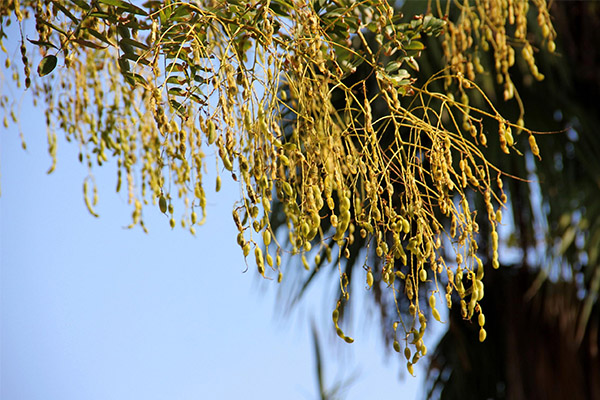
Japanese acacia is beneficial for the curls. Rich in vitamin and mineral compounds, the product provides acceleration of hair growth. Thus, this herb is able to regulate the sebaceous glands, strengthen the curls, ensure normal blood circulation and nutrition of the hair follicles. Means on the basis of this herbal raw material can be used to apply to the scalp in case of pronounced hair loss.
To prepare a useful composition, you should pour 20 g of fruits of culture in 250 ml of hot water and boil on medium heat for a quarter of an hour. After that, the solution should cool, then it should be strained. This decoction can be used for rubbing into the head. This will strengthen the hair follicles.
A remedy consisting of 1 tbsp. of fresh Stifnolobia and a glass of hot water will also be effective. The preparation for 10 minutes is to languish in a steam bath. This decoction will help with alopecia. In such a case, it is necessary to use the solution as a rinse after washing the head with shampoo. It should be noted that such a recipe is used to create a solution designed to eliminate the symptoms of allergic reactions, such as swelling, itching and urticaria, as well as to eliminate psoriasis. It is enough to drink 2 tablespoons of the resulting liquid 3 times a day.
If the hair is falling out, it is necessary to strengthen it, to stimulate its growth. In this case, healing compositions based on Japanese acacia will help. From it produce cosmetic products, when applying which it is recommended to massage the head. This will improve the result.
To make a decoction of the beans you need 20 grams of stifnolobium beans pour a glass of boiled hot water. Cook the mixture over low heat for about 15-20 minutes. Filter the resulting mixture, then rub it into the dermis of the scalp.
Also with alopecia you can use an alcohol-based tincture. Such a remedy should be diluted in a ratio of 1:10 with water before application and rub into the hair roots.
Japanese herb is also useful for the skin. Thus, it is able to strengthen blood vessels and eliminate couperose, stimulate lipid metabolism, narrow the dilated pores, have a rejuvenating effect and increase elasticity. It is recommended to treat hands, feet and elbows with this composition. The plant is useful for dry lips, oily and sensitive type of skin. With the help of such acacia, you can cure acne and pimples, which usually appear at a transitional age. Moreover, such raw materials can restore hormonal balance, relieve inflammation and have a disinfecting effect.
Remedies based on the plant Sophorin help to combat various skin defects, whether they be vascular meshes, purulent inflammation, eczema, wounds, cracked nipples, burns.
Rutin in the composition of such a tree is responsible for accelerating the healing of all dermal defects. For therapeutic purposes, a pharmacy compound in the form of a tincture of sophora in alcohol is used. From the fruits of such a culture is also produced such a drug as "Gum of Sophora japonica". They are used in the treatment of wounds and burns.
To prepare lotions on an alcohol basis at home, you can use vodka without any additives, alcohol, which will need to be diluted to obtain vodka. Suitable for these purposes and cologne, but in this case you will need to make sure that no allergic reaction to the components of such a base.
- To get rejuvenating lotion should be 200 grams of raw materials to pour 500 ml of vodka and insist 2 weeks. After that, the remedy is ready to use, there is no need to filter it. Before using it, you should check the composition for allergic reactions.
- There is another recipe for making lotion at home. To do this, you need 2 tbsp of beans pour 250 ml of boiling water. The resulting mixture should insist 3-4 hours, after which it is ready for use.
- A simpler way to prepare lotion is to dilute 1 tbsp. of pharmacy tincture with ten parts of water. Such a remedy is used to wipe the skin. Such a solution can be used no more than 2 times a week.
How is the Japanese Sophora honey useful?
Styphnolobium honey can be used as a sweetener for sweet dishes. The product is characterized by a mild soothing effect, does not irritate the mucous membranes, is well absorbed and replenishes the energy reserves of the body. Moreover, this product eliminates constipation, has an analgesic effect, and acts as an anti-inflammatory when used externally and internally.
Japanese honey is suitable for both adults and children. It can be consumed to restore strength after an illness. To improve well-being, it is recommended to dissolve 1 tsp. honey in a glass of water and drink the resulting drink.
The composition of such a delicacy allows you to consume it for capillary fragility, to restore metabolism, to prevent atherosclerosis, thrombophlebitis and hemorrhoids. Honey also helps to reduce the value of "bad" cholesterol in the body, to regulate blood pressure, restore the retina, relieve swelling, strengthen defenses. Another advantage of this delicacy is that it can be used for a hangover, to eliminate toxic substances from the body after drinking alcohol.
Stifnolobium honey contains components that promote rapid healing of wounds, normalize the activity of the pancreas, improve digestion, help to recover faster after a stroke. The constituents of such natural treats relieve the stronger sex from impotence, help cope with hair loss.
If a man is not allergic to honey, this substance can be used to eliminate allergic manifestations.
The product is characterized by a fairly high degree of caloric content. So, in 100 g of honey is concentrated 300 kcal. When following a diet, this should be taken into account, limiting the amount of this sweetener.
As is known, any honey is a powerful allergen. Sophora, on the other hand, refers to leguminous crops. Therefore, if you have an allergy to honey or beans, you should give up such a delicacy. Before trying this product for the first time, it is recommended that a small amount of honey be applied to the bend of the hand. If redness or a rash appears, you will have to refuse to use it.
Is it possible to eat the fruits of Sophora japonica

In general, the weeping tree refers to poisonous plants. Fresh fruits are contraindicated for use. And the preparations obtained on its basis can be used internally only after consultation with a specialist, observing the specified dosages.
Contraindications for usage
Medicines derived from the raw material Stifnolobium japonicum, take strictly on prescription, after a doctor's appointment. If you feel worse, you should immediately consult a doctor. Treatment with such drugs is contraindicated in low blood pressure, cystitis, allergies to legumes. Diseases of the cardiovascular system and activities related to work on various mechanisms are also a limitation to the use of such a herbal composition. Children under three years of age and pregnant women should also be excluded from using preparations of this group.
While waiting for the baby, the rutin contained in Sophora stimulates uterine contraction, which can lead to miscarriage or provoke premature labor. If a pregnant woman has kidney failure, liver and heart problems, low blood pressure, it is forbidden to prescribe her sophora medication. If symptoms such as nausea, vomiting and stomach upset appeared, the drug is immediately canceled. During lactation, the product can be used for cracked nipples.
«Important: All information on this site is provided for informational purposes only for informational purposes only. Before applying any recommendations, consult a health care professional. specialist. Neither the editors nor the authors shall be liable for any possible harm caused by materials."

